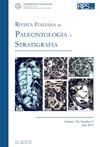BIOSTRATIGRAPHY AND PALEOENVIRONMENTAL ANALYSIS OF THE LOWER MIOCENE QOM FORMATION (JAAM AREA, CENTRAL IRANIAN BASIN)
IF 1.9
3区 地球科学
Q2 GEOLOGY
引用次数: 0
Abstract
Lower Miocene sediments from a previously not investigated outcrop of the Qom Formation (Central Iranian Basin) were studied for their foraminiferal and calcareous nannofossil content. The studied stratigraphic record is assigned to the upper part of calcareous nannofossil NN2 Zone/CN1c Subzone and to the benthic foraminiferal Borelis melo melo Zone of Burdigalian age. The diversity indices, benthic foraminiferal morphogroups, and quantitative analyses of assemblages (principal component and cluster analysis) suggest an overall shallow-marine depositional environment. This interpretation is well constrained based on the dominance of the B1 benthic foraminifera morphotype with biconvex, trochospiral calcareous test, and epifaunal habitat. The identified six cluster groups of benthic foraminiferal assemblages are confirmed by the principal component analysis too, and their distribution along the studied section argue for dynamic changes of the environment. This is well exemplified by a more or less constant shallowing, then deepening trend of the environment as revealed by the shifting from the high diversity, shallow-shelf assemblages of Cluster 5 and 6 toward the low diversity, near-shore Ammonia tepida and Porosononion subgranosus assemblage (Cluster 1), and back.伊朗盆地中部jaam地区中新统下qom组生物地层学与古环境分析
研究人员研究了以前未研究过的Qom组露头中新世下部沉积物(伊朗中部盆地)的有孔虫和钙质纳米化石含量。研究的地层记录属于burdigian时代钙质纳米化石NN2带/CN1c亚带上部和底栖有孔虫Borelis melo melo带。多样性指数、底栖有孔虫形态群和组合的定量分析(主成分分析和聚类分析)表明整体的浅海沉积环境。这一解释是基于B1底栖有孔虫的优势形态,具有双凸、深螺旋钙质试验和脚外栖息地。主成分分析也证实了底栖有孔虫的6个聚类,它们在研究剖面上的分布说明了环境的动态变化。从高多样性的第5和第6集群的浅陆架组合向低多样性的近岸氨温藻和细粒孔洋葱组合(第1集群)的转变,再向后退,表明了环境的不断变浅,然后加深的趋势。
本文章由计算机程序翻译,如有差异,请以英文原文为准。
求助全文
约1分钟内获得全文
求助全文
来源期刊
CiteScore
3.60
自引率
4.30%
发文量
28
审稿时长
>12 weeks
期刊介绍:
The Rivista Italiana di Paleontologia e Stratigrafia was founded in 1895. It publishes original papers dealing with all fields of paleontology and of stratigraphy, from Italy and the Mediterranean to the Tethys, as well across the globe from China to North America.

 求助内容:
求助内容: 应助结果提醒方式:
应助结果提醒方式:


